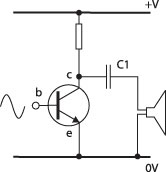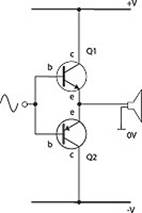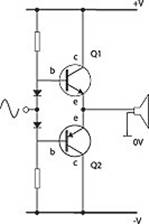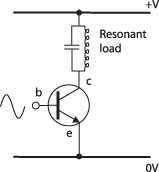Class A
It uses only one transistor and is very loyal. It is used particularly in the case of amplification of low power requiring precision (CD players, etc..).
Its operation is suitable in terms of quality, however its performance is in the best of cases of 50%, which means that in the worst of cases half of the power is lost because this amp tends to heat and consumes even when the input signal is zero. Class A is divided in two Class A1 and A2:
• Class A1 shows that the power stage does not absorb current from the previous stage, it is usually transistors field effect.
• Class A2 means that the final stage absorbs the current from the previous stage, all conventional bipolar transistors satisfy this condition.
 |
A simple single-ended Class-A amplifier. |
Class B
It uses two transistors in push-pull (one draw, while the other drives): one to treat the alternating positive and one negative alternation of the signal. It has the advantage of losing less energy in heat and almost nothing when the input signal is zero, however it distort it the low signal intensity. In high-fidelity, we prefer to substitute this class by the class AB because is more efficient in terms of distortion.
 |
Push-pull Class-B amplifier. |
Class AB
To solve the problem of beam distortion, class AB has been invented. It operates as a Class A in low power (increase conduction time of transistors) and switches on the operation of Class B at higher powers.
It is a widely used class because it offers a good balance between quality of recovery and acceptable performance.
 |
Class-AB amplifier (simplified). |
Class C
They have a "conduction time" of less than half the period of the input signal. The output signal contains several harmonics who are usually filtered by a charging circuit very selective with the center frequency of the signal to be amplified.
This is an unused class in audio because it amplifies only the signal peaks in push-pull. It is very useful in radio because it has a very high yield.
 |
Class-C amplifier with a resonant load. |
To see degrees of amplification click here...